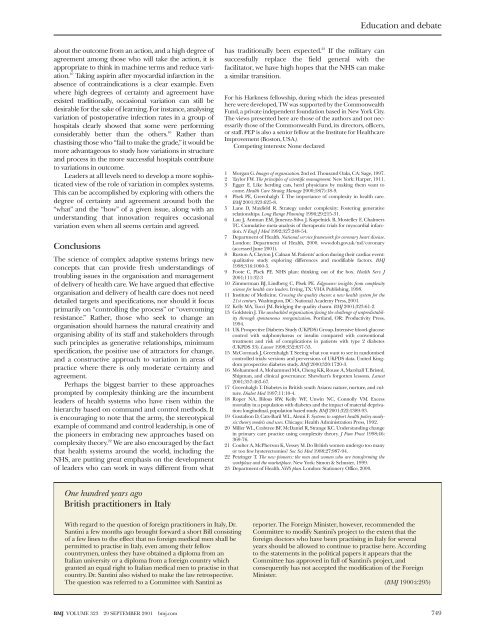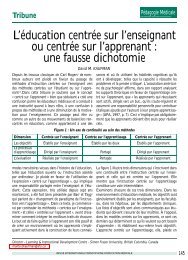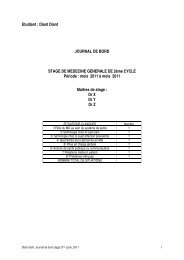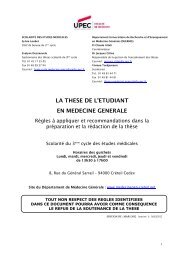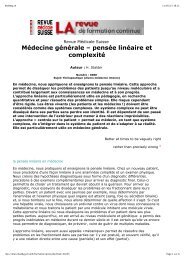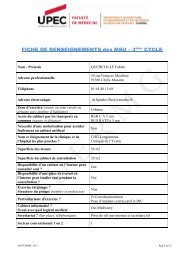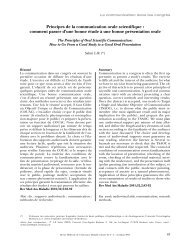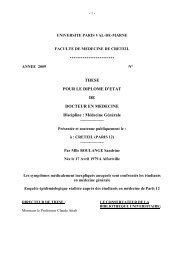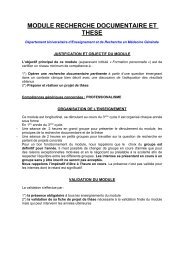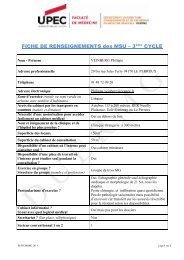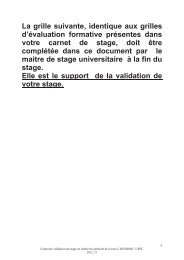Complexity science Complexity, leadership, and management in ...
Complexity science Complexity, leadership, and management in ...
Complexity science Complexity, leadership, and management in ...
You also want an ePaper? Increase the reach of your titles
YUMPU automatically turns print PDFs into web optimized ePapers that Google loves.
Education <strong>and</strong> debate<br />
about the outcome from an action, <strong>and</strong> a high degree of<br />
agreement among those who will take the action, it is<br />
appropriate to th<strong>in</strong>k <strong>in</strong> mach<strong>in</strong>e terms <strong>and</strong> reduce variation.<br />
10 Tak<strong>in</strong>g aspir<strong>in</strong> after myocardial <strong>in</strong>farction <strong>in</strong> the<br />
absence of contra<strong>in</strong>dications is a clear example. Even<br />
where high degrees of certa<strong>in</strong>ty <strong>and</strong> agreement have<br />
existed traditionally, occasional variation can still be<br />
desirable for the sake of learn<strong>in</strong>g. For <strong>in</strong>stance, analys<strong>in</strong>g<br />
variation of postoperative <strong>in</strong>fection rates <strong>in</strong> a group of<br />
hospitals clearly showed that some were perform<strong>in</strong>g<br />
considerably better than the others. 16<br />
Rather than<br />
chastis<strong>in</strong>g those who “fail to make the grade,” it would be<br />
more advantageous to study how variations <strong>in</strong> structure<br />
<strong>and</strong> process <strong>in</strong> the more successful hospitals contribute<br />
to variations <strong>in</strong> outcome.<br />
Leaders at all levels need to develop a more sophisticated<br />
view of the role of variation <strong>in</strong> complex systems.<br />
This can be accomplished by explor<strong>in</strong>g with others the<br />
degree of certa<strong>in</strong>ty <strong>and</strong> agreement around both the<br />
“what” <strong>and</strong> the “how” of a given issue, along with an<br />
underst<strong>and</strong><strong>in</strong>g that <strong>in</strong>novation requires occasional<br />
variation even when all seems certa<strong>in</strong> <strong>and</strong> agreed.<br />
Conclusions<br />
The <strong>science</strong> of complex adaptive systems br<strong>in</strong>gs new<br />
concepts that can provide fresh underst<strong>and</strong><strong>in</strong>gs of<br />
troubl<strong>in</strong>g issues <strong>in</strong> the organisation <strong>and</strong> <strong>management</strong><br />
of delivery of health care. We have argued that effective<br />
organisation <strong>and</strong> delivery of health care does not need<br />
detailed targets <strong>and</strong> specifications, nor should it focus<br />
primarily on “controll<strong>in</strong>g the process” or “overcom<strong>in</strong>g<br />
resistance.” Rather, those who seek to change an<br />
organisation should harness the natural creativity <strong>and</strong><br />
organis<strong>in</strong>g ability of its staff <strong>and</strong> stakeholders through<br />
such pr<strong>in</strong>ciples as generative relationships, m<strong>in</strong>imum<br />
specification, the positive use of attractors for change,<br />
<strong>and</strong> a constructive approach to variation <strong>in</strong> areas of<br />
practice where there is only moderate certa<strong>in</strong>ty <strong>and</strong><br />
agreement.<br />
Perhaps the biggest barrier to these approaches<br />
prompted by complexity th<strong>in</strong>k<strong>in</strong>g are the <strong>in</strong>cumbent<br />
leaders of health systems who have risen with<strong>in</strong> the<br />
hierarchy based on comm<strong>and</strong> <strong>and</strong> control methods. It<br />
is encourag<strong>in</strong>g to note that the army, the stereotypical<br />
example of comm<strong>and</strong> <strong>and</strong> control <strong>leadership</strong>, is one of<br />
the pioneers <strong>in</strong> embrac<strong>in</strong>g new approaches based on<br />
complexity theory. 22 We are also encouraged by the fact<br />
that health systems around the world, <strong>in</strong>clud<strong>in</strong>g the<br />
NHS, are putt<strong>in</strong>g great emphasis on the development<br />
of leaders who can work <strong>in</strong> ways different from what<br />
has traditionally been expected. 23<br />
If the military can<br />
successfully replace the field general with the<br />
facilitator, we have high hopes that the NHS can make<br />
a similar transition.<br />
For his Harkness fellowship, dur<strong>in</strong>g which the ideas presented<br />
here were developed, TW was supported by the Commonwealth<br />
Fund, a private <strong>in</strong>dependent foundation based <strong>in</strong> New York City.<br />
The views presented here are those of the authors <strong>and</strong> not necessarily<br />
those of the Commonwealth Fund, its directors, officers,<br />
or staff. PEP is also a senior fellow at the Institute for Healthcare<br />
Improvement (Boston, USA).<br />
Compet<strong>in</strong>g <strong>in</strong>terests: None declared<br />
1 Morgan G. Images of organization.2nd ed. Thous<strong>and</strong> Oaks, CA: Sage, 1997.<br />
2 Taylor FW.The pr<strong>in</strong>ciples of scientific <strong>management</strong>. New York: Harper, 1911.<br />
3 Egger E. Like herd<strong>in</strong>g cats, herd physicians by mak<strong>in</strong>g them want to<br />
come. Health Care Strateg Manage 2000;18(7):18-9.<br />
4 Plsek PE, Greenhalgh T. The importance of complexity <strong>in</strong> health care.<br />
BMJ 2001;323:625-8.<br />
5 Lane D, Maxfield R. Strategy under complexity: Foster<strong>in</strong>g generative<br />
relationships. Long Range Plann<strong>in</strong>g 1996;29:215-31.<br />
6 Lau J, Antman EM, Jimenez-Silva J. Kupelnick B, Mosteller F, Chalmers<br />
TC. Cumulative meta-analysis of therapeutic trials for myocardial <strong>in</strong>farction.<br />
N Engl J Med 1992;327:248-54.<br />
7 Department of Health. National service framework for coronary heart disease.<br />
London: Department of Health, 2000. www.doh.gov.uk/nsf/coronary<br />
(accessed June 2001).<br />
8 Ruston A, Clayton J, Calnan M. Patients’ action dur<strong>in</strong>g their cardiac event:<br />
qualitative study explor<strong>in</strong>g differences <strong>and</strong> modifiable factors. BMJ<br />
1998;316:1060-5.<br />
9 Foote C, Plsek PE. NHS plan: th<strong>in</strong>k<strong>in</strong>g out of the box. Health Serv J<br />
2001;111:32-3<br />
10 Zimmerman BJ, L<strong>in</strong>dberg C, Plsek PE. Edgeware: <strong>in</strong>sights from complexity<br />
<strong>science</strong> for health care leaders. Irv<strong>in</strong>g, TX: VHA Publish<strong>in</strong>g, 1998.<br />
11 Institute of Medic<strong>in</strong>e. Cross<strong>in</strong>g the quality chasm: a new health system for the<br />
21st century. Wash<strong>in</strong>gton, DC: National Academy Press, 2001.<br />
12 Kelly MA, Tucci JM. Bridg<strong>in</strong>g the quality chasm. BMJ 2001;323:61-2.<br />
13 Goldste<strong>in</strong> J. The unshackled organization: fac<strong>in</strong>g the challenge of unpredictability<br />
through spontaneous reorganization. Portl<strong>and</strong>, OR: Productivity Press,<br />
1994.<br />
14 UK Prospective Diabetes Study (UKPDS) Group. Intensive blood-glucose<br />
control with sulphonylureas or <strong>in</strong>sul<strong>in</strong> compared with conventional<br />
treatment <strong>and</strong> risk of complications <strong>in</strong> patients with type 2 diabetes<br />
(UKPDS 33). Lancet 1998;352:837-53.<br />
15 McCormack J, Greenhalgh T. See<strong>in</strong>g what you want to see <strong>in</strong> r<strong>and</strong>omised<br />
controlled trials: versions <strong>and</strong> perversions of UKPDS data. United K<strong>in</strong>gdom<br />
prospective diabetes study. BMJ 2000;320:1720-3.<br />
16 Mohammed A, Mohammed MA, Cheng KK, Rouse A, Marshall T. Bristol,<br />
Shipman, <strong>and</strong> cl<strong>in</strong>ical governance: Shewhart’s forgotten lessons. Lancet<br />
2001;357:463-67.<br />
17 Greenhalgh T. Diabetes <strong>in</strong> British south Asians: nature, nurture, <strong>and</strong> culture.<br />
Diabet Med 1997;11:10-4.<br />
18 Roper NA, Bilous RW, Kelly WF, Unw<strong>in</strong> NC, Connolly VM. Excess<br />
mortality <strong>in</strong> a population with diabetes <strong>and</strong> the impact of material deprivation:<br />
longitud<strong>in</strong>al, population based study. BMJ 2001;322:1389-93.<br />
19 Gustafson D, Cats-Baril WL, Alemi F. Systems to support health policy analysis:<br />
theory models <strong>and</strong> uses. Chicago: Health Adm<strong>in</strong>istration Press, 1992.<br />
20 Miller WL, Crabtree BF, McDaniel R, Strange KC. Underst<strong>and</strong><strong>in</strong>g change<br />
<strong>in</strong> primary care practice us<strong>in</strong>g complexity theory. J Fam Pract 1998;46:<br />
369-76.<br />
21 Coulter A, McPherson K, Vessey M. Do British women undergo too many<br />
or too few hysterectomies? Soc Sci Med 1988;27:987-94.<br />
22 Petz<strong>in</strong>ger T. The new pioneers: the men <strong>and</strong> women who are transform<strong>in</strong>g the<br />
workplace <strong>and</strong> the marketplace. New York: Simon & Schuster, 1999.<br />
23 Department of Health. NHS plan. London: Stationery Office, 2000.<br />
One hundred years ago<br />
British practitioners <strong>in</strong> Italy<br />
With regard to the question of foreign practitioners <strong>in</strong> Italy, Dr.<br />
Sant<strong>in</strong>i a few months ago brought forward a short Bill consist<strong>in</strong>g<br />
of a few l<strong>in</strong>es to the effect that no foreign medical men shall be<br />
permitted to practise <strong>in</strong> Italy, even among their fellow<br />
countrymen, unless they have obta<strong>in</strong>ed a diploma from an<br />
Italian university or a diploma from a foreign country which<br />
granted an equal right to Italian medical men to practise <strong>in</strong> that<br />
country. Dr. Sant<strong>in</strong>i also wished to make the law retrospective.<br />
The question was referred to a Committee with Sant<strong>in</strong>i as<br />
reporter. The Foreign M<strong>in</strong>ister, however, recommended the<br />
Committee to modify Sant<strong>in</strong>i’s project to the extent that the<br />
foreign doctors who have been practis<strong>in</strong>g <strong>in</strong> Italy for several<br />
years should be allowed to cont<strong>in</strong>ue to practise here. Accord<strong>in</strong>g<br />
to the statements <strong>in</strong> the political papers it appears that the<br />
Committee has approved <strong>in</strong> full of Sant<strong>in</strong>i’s project, <strong>and</strong><br />
consequently has not accepted the modification of the Foreign<br />
M<strong>in</strong>ister.<br />
(BMJ 1900:i:295)<br />
BMJ VOLUME 323 29 SEPTEMBER 2001 bmj.com<br />
749


